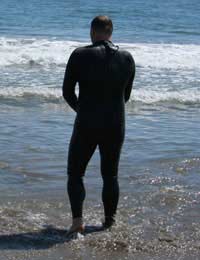What is Body Surfing?

Body surfing is the purist’s wave riding watersport and also a great way to experience the thrills of surfing without the expense of a board.
What is Body Surfing?
Body surfing is the riding of waves without any board or other equipment. Riders instead use their body as a surfboard.Body surfers generally regard their minimalist surfing discipline as the purest of all the wave riding sports as participants are not reliant on any man-made aids and are as open and close to the elements as possible.
The body does not have the same aerodynamic qualities of a specially designed board and so body surfing is slower than its board cousins.
Is Body Surfing Safe?
Considering the types of seas suitable for body surfing are also some of the most dangerous, risk is an unavoidable aspect of the sport. However safety awareness should also be an integral part of body surfing because with it the risks can be minimised.Safety awareness is a key part of body surfing training. However as well as teaching all aspects of beach safety, the risks for beginners are minimised further by learning the correct body surfing skills so that they can enter the water with good confidence and ability.
Safe Beginnings
The basic beginners’ body surfing technique can be summarised in the following stages:- Firstly work out where the waves are breaking and position yourself slightly beyond them.
- Front crawl swim in the same direction as an approaching wave so the wave overtakes just before it breaks.
- Decide whether to ride left or right once you feel the wave begin to grab. The best and longest ride is achieved by heading away from the breaking part of the wave.
- Stop stroking but keep kicking and then extend the shoreward arm forward, keeping your palm down and breaking the surface of the water.
- Streamline your body and continue riding the wave for as long as is desired or is possible.
Body Surfing Gear
Body surfers pride themselves on their lack of gear but there are a couple of items that all novice riders should invest in - namely swim fins and a wetsuit.Body surfing is certainly possible without swim fins, but for beginners it is much easier and more fun with them, especially with larger waves.
As the UK is not surrounded by tropical waters, at least not yet, it is advisable to always wear a wetsuit when staying in the water for any significant length of time, even in the summer.
General Safety Advice
For safe surfing riders should know their beach well. They should be familiar with the layout of the beach at low tide, noting the positions of any sandbanks and rocks. Sandbanks, for instance, can be a saviour if a rider is caught out of their depth. Hidden rocks, on the other hand, can prove dangerous for the unsuspecting surfer.Novice body surfers should never go out of their depth, a rule particularly important when the seas are rough, and the waves are large. More experienced riders are advised against breaking this rule, but if doing so must wear flippers. In addition to this it is recommended that when there is any significant undertow, riders should not venture deeper than chest height and always keep one set of toes anchored to the sand.
Novices, and ideally everyone, should try to surf in beach areas patrolled by the Surf Life Savers Association (SLSA) and within their designated safe areas, as indicated by the red and yellow flags. These are no randomly selected areas but chosen to avoid any rip tides.
Rip Tides
Rip tides are strong underwater seaward currents that are not visible to the naked eye but can drag a surfer out to sea and as such are potentially very dangerous.If caught in a rip tide, surfers are advised never to try to swim back into shore directly but swim sideways towards an area less affected by it. Strong swimmers usually can get away with swimming 45 degrees to the shoreline.


Re: Parasailing
Can i know where can i do parasailing near brighton area in uk. Can you also send me the prices for it. Thank you
Re: Top UK Windsurfing Spots
Hi I've got a windsurf but I've never done anything like this is it easy to do and wear would I be best to practice
Re: Parasailing
I am 50 in april really want to do this para sailing
Re: Swimming in Rivers and Lakes
Swansswimmer - Your Question:A fine article containing good advice. I wish to add that the wearing of a wetsuit is not necessary.…
Re: Swimming in Rivers and Lakes
A fine article containing good advice. I wish to add that the wearing of a wetsuit is not necessary. I wore one as did my new…
Re: Parasailing
Gert - Your Question:Would like to have some information on where and how to book a parasailing eventO
Re: Banana Boats and Other Holiday Activities
Who regulates banana boating and similar activities in the UK?